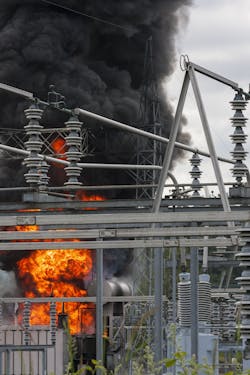Substation Fire in Wisconsin Linked to Mechanical Failure
According to a press release from American Transmission Co. (ATC), the electric utility continues to provide information on the recent substation fires in Madison, Wis., including the latest investigation findings, environmental cleanup efforts, and when a new transformer will be operational. As background, an ATC transformer caught fire at Madison Gas & Electric’s Blount Street Substation at 7:39 a.m. on Friday, July 19. A few minutes later, a second fire occurred at the East Campus Substation. The two substations are electrically connected by underground cables. Both fires were extinguished by approximately 9 a.m.
ATC investigated the cause of the transformer fire with the help of the Electric Power Research Institute. Together, ATC and EPRI performed a visual inspection of the damaged transformer at Blount Substation a few days after the fire and then conducted a controlled teardown of the transformer to disassemble and inspect the condition of various components to better understand the cause.
As previously shared, prior to the fire, ATC had been closely monitoring a component on the Blount transformer because of observed anomalies. ATC consulted with the component manufacturer, conducted additional inspections July 15, 16, and 17 — and made plans to take the transformer out of service for a detailed internal inspection on July 22.
“Based on our experience and consultation with the manufacturer, we took prudent action in scheduling the outage,” said Jim Vespalec, ATC director of asset planning and engineering. “While the transformer suffered considerable damage in the fire, the inspection and teardown showed that the failure originated in the voltage regulating component due to mechanical failure, generating combustible gases and resulting in a fire.”
ATC continues to work in coordination with and under the direction of the Department of Natural Resources to contain, collect and properly dispose of the transformer’s insulating fluid and the water used to extinguish the fire. There were approximately 18,000 gallons of insulating fluid in the transformer to insulate and cool the electrical components. A significant portion of the insulating fluid was recovered and collected into tanks for recycling under the direction of the DNR. The DNR also asked ATC to contain and collect water from the stormwater system that the fire department used to extinguish the fire. With high lake levels at the time of the fire, there is no reason to believe any water was discharged into the waterways. The DNR also asked ATC to test for concentration levels of PFAS, which is a chemical in firefighting foam used to contain the fire. ATC is working with the city of Madison and the DNR to treat approximately 180,000 gallons of recovered water to remove PFAS. Additional monitoring and coordination with the DNR will continue to determine if further action may be needed.
ATC has been working to get the transmission equipment at Blount Substation back to working order. A new transformer sits on a new concrete pad in the substation, and the necessary electrical connections and tests are being completed with the goal of putting the new transformer in service by mid-October. Within a week of the fire, ATC made immediate transmission repairs at the East Campus Substation to make it operational. More permanent repairs are planned for 2020.
According to ATC, failures like this are extremely rare, and the company is conducting internal reviews and consulting industry peers to identify if any changes in work practices are necessary.
